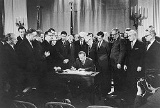
Civil Rights Act of 1968
Overview
On April 11, 1968 U.S. President Lyndon B. Johnson
Lyndon B. Johnson
Lyndon Baines Johnson , often referred to as LBJ, was the 36th President of the United States after his service as the 37th Vice President of the United States...
signed the Civil Rights Act of 1968, also known as the Indian Civil Rights Act of 1968
Indian Civil Rights Act of 1968
The Indian Civil Rights Act of 1968 applies to the Indian tribes of the United States and makes many, but not all, of the guarantees of the Bill of Rights applicable within the tribes. The Act appears today in Title 25, sections 1301 to 1303 of the United States Code.- Events before passage of...
. Title VIII of the Civil Rights Act of 1968 is commonly known as the Fair Housing Act, or as CRA '68, and was meant as a follow-up to the Civil Rights Act of 1964
Civil Rights Act of 1964
The Civil Rights Act of 1964 was a landmark piece of legislation in the United States that outlawed major forms of discrimination against African Americans and women, including racial segregation...
. While the Civil Rights Act of 1866
Civil Rights Act of 1866
The Civil Rights Act of 1866, , enacted April 9, 1866, is a federal law in the United States that was mainly intended to protect the civil rights of African-Americans, in the wake of the American Civil War...
prohibited discrimination in housing, there were no federal enforcement provisions. The 1968 act expanded on previous acts and prohibited discrimination concerning the sale, rental, and financing of housing based on race, religion, national origin, and since 1974, gender
Gender
Gender is a range of characteristics used to distinguish between males and females, particularly in the cases of men and women and the masculine and feminine attributes assigned to them. Depending on the context, the discriminating characteristics vary from sex to social role to gender identity...
; since 1988, the act protects people with disabilities and families with children.
Unanswered Questions

